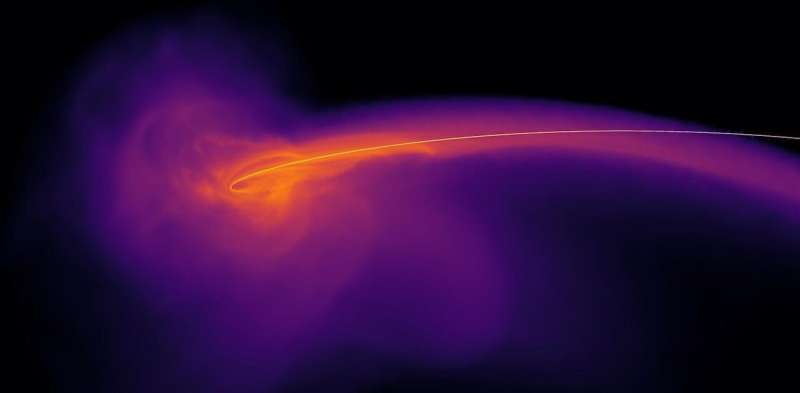
Source: Price et al. (2024)
Giant black holes at the center of galaxies like our own Milky Way are known to occasionally devour nearby stars.
This leads to a dramatic and complex process in which the star, which is hurtling towards the supermassive black hole, is spaghettified and blasted to pieces. The resulting fireworks display is called a tidal destruction event.
In a new study published today in The Letters of the Astrophysical Journalwe have created the most detailed simulations to date that show the course of this process over the course of a year.
A black hole tears apart a sun
American astronomer Jack G. Hills and British astronomer Martin Rees first theorized about tidal destruction events in the 1970s and 80s. Rees’ theory predicted that half of the star’s debris would remain bound to the black hole and collide with itself to form a hot, glowing vortex of material called an accretion disk. The disk would be so hot that it would emit large amounts of X-rays.
But to everyone’s surprise, most of the more than 100 possible tidal destruction events discovered so far turned out to glow primarily in the visible wavelength range, rather than in the X-ray range. The observed temperatures in the debris were only 10,000 degrees Celsius – that’s the surface of a moderately warm star, rather than the millions of degrees you’d expect from hot gas around a supermassive black hole.
Even stranger is the estimated size of the luminous material surrounding the black hole: it is several times larger than our solar system and is rapidly expanding away from the black hole at a few percent of the speed of light.
Given that even a black hole with the mass of a million suns is only slightly larger than our Sun, the enormous size of the glowing ball of matter deduced from observations was a complete surprise.
Astrophysicists have speculated that the black hole must somehow be smothered by matter during the disruption to explain the lack of X-ray emissions. But so far no one has been able to show how this actually happens. This is where our simulations come in.
A slurp and a burp
Black holes are messy eaters—not unlike a five-year-old with a bowl of spaghetti. A star starts out as a compact body but becomes spaghettified: it is stretched into a long, thin strand by the extreme tides of the black hole.
Although half of the matter from the now-shattered star is hurled towards the black hole, only 1% of it is actually swallowed. The rest is blown away by the black hole in a kind of cosmic “burp”.
Simulating tidal currents with a computer is difficult. Newton’s laws of gravity don’t apply near a supermassive black hole, so you have to take into account all the weird and wonderful effects of Einstein’s general theory of relativity.
But PhD students are for hard work. Our recent graduate, David Liptai, developed a new simulation method based on Einstein’s method that allowed the team to experiment by hurling unsuspecting stars in the general direction of the nearest black hole. You can even do it yourself.
The resulting simulations, seen in the videos here, are the first to show tidal disruptions ranging from slurping to burping.
They follow the spaghettification of the star up to the point where the debris falls back onto the black hole, and then a close approach that turns the stream into something resembling a wriggling garden hose. The simulation runs for more than a year after the initial fall.
It took more than a year to run on one of Australia’s most powerful supercomputers. The scaled-down version is as follows:
What did we find out?
Much to our surprise, we found that the 1% of material falling into the black hole generates so much heat that it creates an extremely powerful and nearly spherical outflow. (A bit like when you ate too much curry, and for the same reason.)
The black hole simply cannot swallow too much, so the amount it cannot swallow suffocates the central engine and is steadily ejected.
When observed as seen with our telescopes, the simulations explain a lot. It turns out that previous researchers were right in their assessment of the suffocation. It looks like this:
The new simulations show why tidal forces actually look like a solar system-sized star expanding at a few percent of the speed of light and powered by a black hole at its core. You could even call it a “black hole sun.”
Provided by The Conversation
This article is republished from The Conversation under a Creative Commons license. Read the original article.![]()
Quote: Watch a star being destroyed by a supermassive black hole in the first simulation of its kind (24 August 2024), retrieved 24 August 2024 from https://phys.org/news/2024-08-star-destroyed-supermassive-black-hole.html
This document is subject to copyright. Except for the purposes of private study or research, no part of it may be reproduced without written permission. The contents are for information purposes only.

